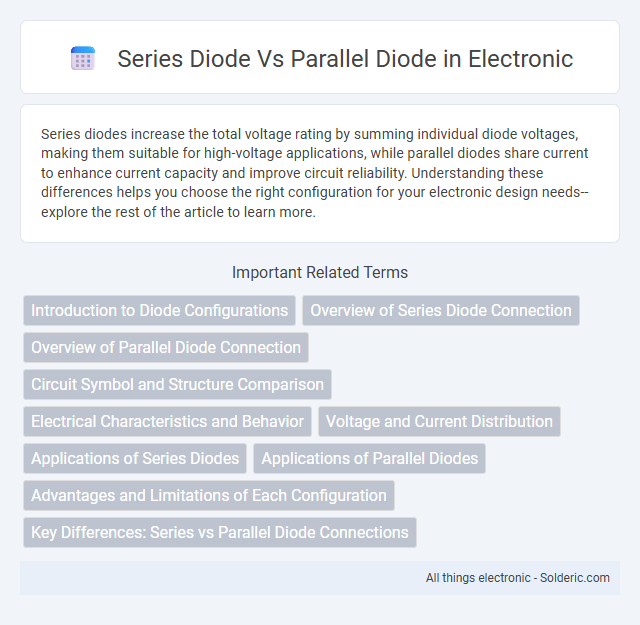Series diodes increase the total voltage rating by summing individual diode voltages, making them suitable for high-voltage applications, while parallel diodes share current to enhance current capacity and improve circuit reliability. Understanding these differences helps you choose the right configuration for your electronic design needs--explore the rest of the article to learn more.
Comparison Table
| Feature | Series Diode | Parallel Diode |
|---|---|---|
| Configuration | Connected end-to-end in a single path | Connected side-by-side across the circuit |
| Voltage Handling | Increases total voltage rating by sum of diode voltages | Voltage rating equal to a single diode's voltage limit |
| Current Handling | Current limited to a single diode's maximum rating | Current divided among diodes, increasing total current capacity |
| Failure Impact | Series diode failure opens the circuit, stopping current flow | Parallel diode failure may increase current load on remaining diodes |
| Applications | High voltage circuits, voltage dropping | High current applications, load sharing |
| Complexity | Simple wiring, less complexity | Requires current balancing resistors or matching diodes |
Introduction to Diode Configurations
Series diode configurations connect multiple diodes end-to-end, increasing the overall voltage rating by summing individual diode voltages while maintaining the same current rating. Parallel diode configurations connect diodes side-by-side, allowing current sharing to enhance current handling capability while keeping the voltage rating equal to that of a single diode. Understanding these configurations is essential for optimizing circuit performance in applications requiring specific voltage and current characteristics.
Overview of Series Diode Connection
A series diode connection involves aligning multiple diodes end-to-end so that the current flows sequentially through each diode, increasing the overall voltage rating of the circuit. This configuration is commonly used to handle higher voltage levels that a single diode cannot withstand, as the voltage is divided across all diodes in the series. Key considerations include ensuring uniform current distribution and selecting diodes with similar characteristics to prevent uneven voltage stress and potential damage.
Overview of Parallel Diode Connection
Parallel diode connections distribute current evenly across multiple diodes, enhancing overall current capacity and providing redundancy for circuit protection. These configurations are commonly used in power supply circuits and rectifiers to ensure stable performance and reduce individual diode stress. Understanding how your circuit's current demands influence the choice of parallel diode connection can improve reliability and efficiency.
Circuit Symbol and Structure Comparison
Series diodes are connected end-to-end with the anode of one diode linked to the cathode of the next, forming a single path for current flow, represented by multiple diode symbols aligned sequentially in circuit diagrams. Parallel diodes have their corresponding terminals connected together, either all anodes or all cathodes, providing multiple current paths; their circuit symbol shows diodes branching from a common node. Structurally, series diodes increase voltage handling capability by dividing voltage across each diode, while parallel diodes share current load to enhance current capacity without affecting individual diode voltage ratings.
Electrical Characteristics and Behavior
Series diodes exhibit a higher combined forward voltage drop equal to the sum of individual diode drops, resulting in reduced current flow at a given voltage. Parallel diodes share the current load, which decreases the overall forward resistance but require closely matched forward voltage characteristics to prevent unequal current distribution. In terms of reverse bias, series diodes increase the total reverse voltage rating, while parallel diodes maintain the same reverse voltage rating as a single diode.
Voltage and Current Distribution
In series diode configurations, the same current flows through each diode while the voltage divides across them, making voltage rating critical for each diode to prevent breakdown. Parallel diode arrangements share the voltage equally across all diodes, but the current splits depending on each diode's characteristics, requiring careful matching to ensure balanced current distribution. Understanding these voltage and current behaviors helps optimize Your circuit's reliability and performance when selecting diode configurations.
Applications of Series Diodes
Series diodes are commonly used in applications requiring higher voltage ratings, such as in high-voltage rectifiers and voltage multipliers, where multiple diodes share the voltage drop. They provide increased reverse voltage protection in power supply circuits and ensure safe operation in surge protection devices by preventing voltage spikes. Series diode configurations are essential in ensuring reliability in circuits exposed to high-voltage stress and transient conditions.
Applications of Parallel Diodes
Parallel diodes are commonly used in power supply circuits to provide voltage regulation and overvoltage protection by allowing current to bypass sensitive components. They play a crucial role in clamping voltage spikes and protecting circuits from transient voltage surges, especially in inductive load applications. Your devices benefit from enhanced reliability and longevity when parallel diodes are employed to prevent damage caused by reverse voltage or switching noise.
Advantages and Limitations of Each Configuration
Series diode configurations offer advantages such as increased voltage handling capacity and improved reverse voltage protection, making them suitable for high-voltage applications. However, they are limited by voltage drop accumulation and sensitivity to failure of a single diode, which can disrupt the entire circuit. Parallel diode setups provide better current sharing and redundancy, enhancing reliability for high-current systems, but they face challenges like unequal current distribution and potential thermal runaway.
Key Differences: Series vs Parallel Diode Connections
Series diode connections increase the overall voltage rating by summing the individual diode voltages, making them suitable for high-voltage applications. Parallel diode connections share the current load, enhancing the total current capacity and providing redundancy in circuits. Series diodes require voltage balancing to prevent uneven voltage distribution, whereas parallel diodes need current sharing measures to avoid thermal runaway.
Series diode vs parallel diode Infographic

 solderic.com
solderic.com